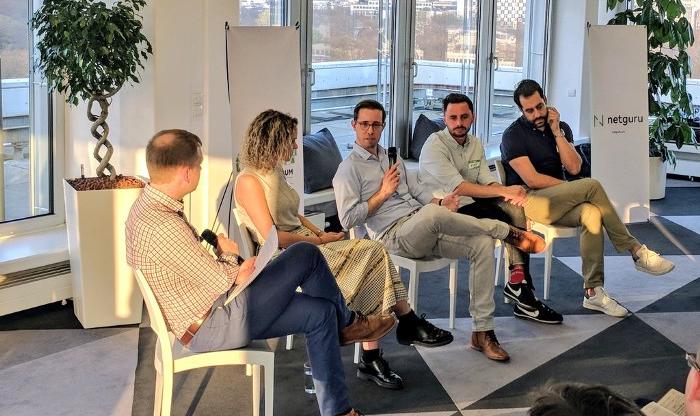Product Design in Fintech Meetup: Are there emotions in banking?
3 minute read


“You can try to build a bank, with the idea of putting emotions in banking, and obviously N26 is super good in that — much better than any other bank, at least in Germany — but my question is: are there really any emotions in banking?” –Jörg Howein
The panel discussion at Netguru’s Disruption Forum: Berlin Fintech Edition in mid-April was initially meant to address the topic of design in fintech. Soon after beginning, however, the conversation amongst the panelists — key members of the Berlin fintech community — wandered off to an interesting debate on “how banking will look in the future”, sparking the question: Are emotions an important part of banking today?
“I think there are huge emotions in money. If you are thinking about your savings account, you want to visualize not only the stuff you can buy from it, but also the liquidity in and of itself.” — Kuba Filipowski
With plenty of focus on APIs, open banking, and crypto, emotions in banking is a topic that is rather overlooked in panels and fintech events today. Alongside an ever-growing choice and disruption of banking products on the market, customers have plenty of ways to choose their preferred mode of banking. The discussion was first divided on the source that customers actually go to when choosing their financial services: whether a) customers prefer a “one-stop bank stop” where all their products are bundled onto one provider or platform; or b) if the need for contextual banking drives providers — other than banks — to cater both the product and the relevant financial services solution to the end customer. The subject of emotions arose when the panelists each shed light on the way that emotions come into play during the customer banking journey.
“When your product name is used as a verb, that’s a measure of success.” -Meaghan Johnson
Customer experience expert Meaghan Johnson discussed how successful fintech brands like Venmo revolutionized the peer-to-peer payment journey in the U.S. Users of Venmo foster a highly social component by sending money directly to their mobile contacts, which can also be attributed to the app’s seamless mobile customer journey. She argued that the impact of a successful fintech in everyday life can be best illustrated when a brand becomes a verb e.g. “I’ll Venmo you”. As a result, everyday use of the financial product gives the customer an emotion or emotional attachment — even if they don’t know it.
“Banking obviously has a strong emotional component. Why do certain banking products arise? Credit is there to buy something you cannot afford, savings is there to prepare for something that might happen in the future.” — Lorenz Jüngling
N26 CPO Lorenz Jüngling elaborated on this statement, bringing up the financial literacy angle of modern banking — that not everybody can understand a financial product. What technology should enable us to do is to provide customers with an easy way to understand their personal finances, e.g. what they can and cannot afford. With tools like voice recognition, he suggested that the next step in the customer journey might be to use these tools to directly ask their financial services provider whether they can afford something like to go on vacation.
“Do you really have emotions with banking? I might feel emotions when I drive my fancy car or wear an expensive leather jacket, or when I decide to go traveling around the world. That’s emotional.” -Jörg Howein
The short but rather insightful debate on the use of emotions in banking today showed that both sides could not agree on or vote for one approach explicitly, especially when connected to the larger question of “one-stop bank shops” versus contextual banking needs. Seeing both banking approaches on the market now will allow banks and financial services providers to have more actionable insights in the next couple of years, allowing them room to adapt to users’ wants, needs, and emotions accordingly.
What are your thoughts on emotions in banking?